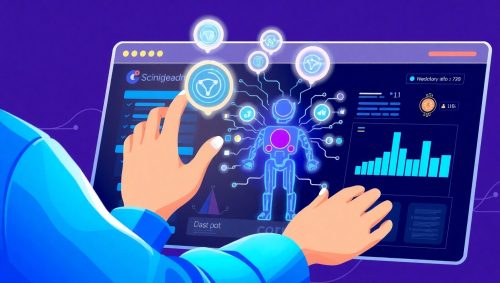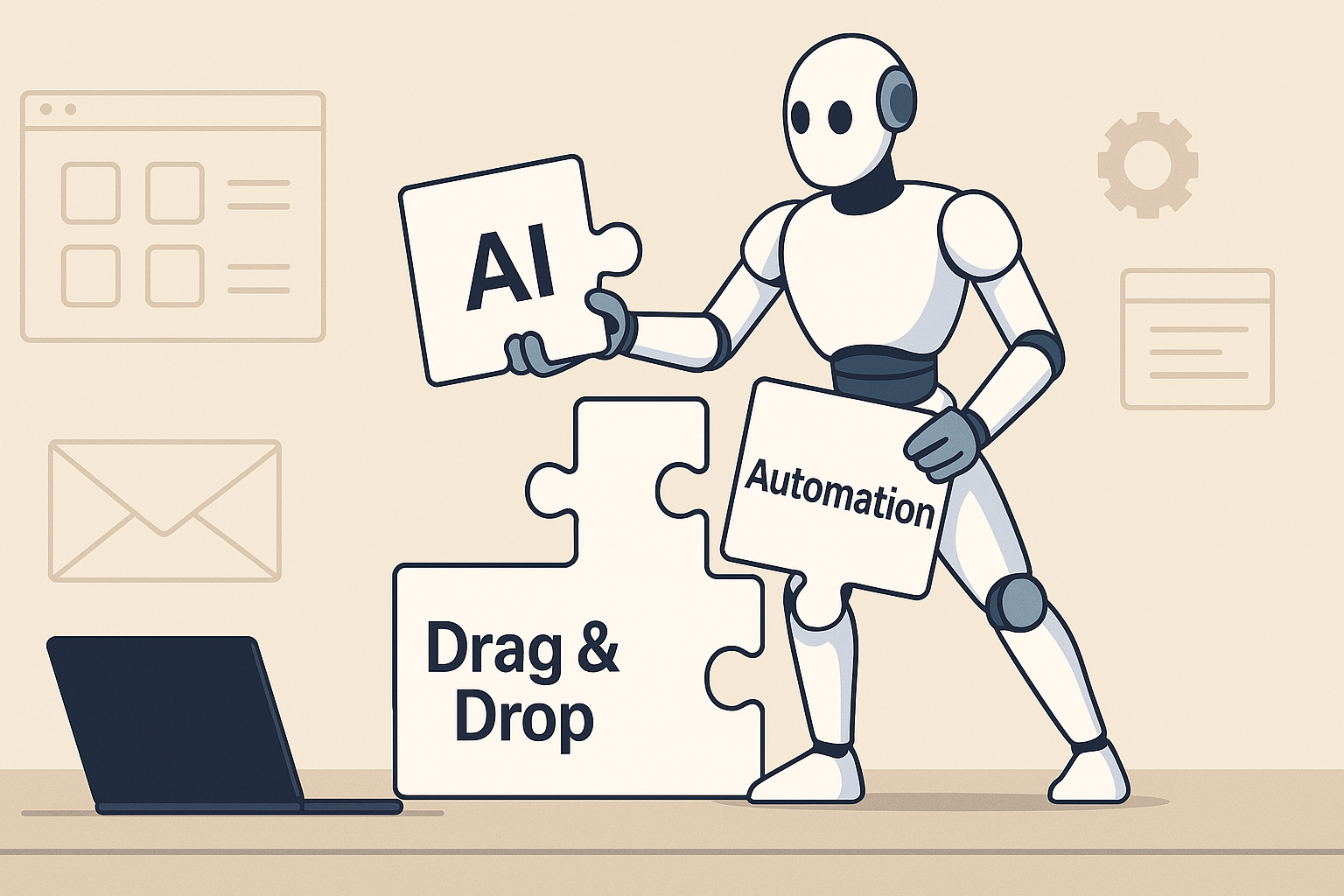In today’s rapidly evolving digital landscape, the ability to create sophisticated AI agents without extensive coding knowledge has become a game-changer for businesses and individuals alike. These no-code AI platforms democratize technology, enabling users to design, deploy, and manage intelligent agents that can automate tasks, enhance customer interactions, and streamline operations. This comprehensive guide will walk you through the process of building AI agents using no-code platforms, highlighting key tools, steps, and best practices to ensure success.
Understanding AI Agents and Their Importance
AI agents are autonomous programs designed to perform tasks, make decisions, and interact with users or other systems with minimal human intervention. They leverage artificial intelligence to process information, learn from data, and execute actions that mimic human behavior. The significance of AI agents lies in their ability to handle repetitive tasks, provide personalized experiences, and operate continuously without fatigue, thereby increasing efficiency and reducing operational costs.
The Rise of No-Code AI Platforms

Traditionally, developing AI agents required substantial programming skills and a deep understanding of machine learning algorithms. However, the emergence of no-code AI platforms has transformed this landscape by providing user-friendly interfaces that allow individuals without technical backgrounds to build and deploy AI agents. These platforms utilize visual development environments, drag-and-drop functionalities, and pre-built templates to simplify the creation process.
Benefits of Building AI Agents with No-Code Platforms
- Accessibility: Empowers non-technical users to create AI solutions, fostering innovation across various sectors.
- Speed: Accelerates the development process, enabling rapid prototyping and deployment.
- Cost-Effectiveness: Reduces the need for specialized developers, lowering the overall cost of AI implementation.
- Flexibility: Allows for easy modifications and scalability as business needs evolve.
Top No-Code AI Agent Builder Platforms
Here are some leading no-code platforms that facilitate the creation of AI agents:
1. Relevance AI
Relevance AI offers a platform where users can build, train, and onboard AI agents without any coding. It provides features like process teaching, integration with existing tech stacks, and a library of templates to get started quickly.
2. n8n
n8n is an open-source workflow automation tool that enables users to create complex automations and AI agents. Its self-hosting capabilities provide full control over data and processes.
3. Vertex AI Agent Builder by Google Cloud
Vertex AI Agent Builder allows users to design, deploy, and manage conversational AI agents using natural language. It combines prompt-based tools with pre-built templates for rapid development without extensive coding.
4. AppyPie
AppyPie is a no-code development platform that enables users to create mobile applications, websites, chatbots, and automated workflows without traditional programming. It primarily serves small and mid-sized businesses, startups, and entrepreneurs.
5. Zapier Central
Zapier Central is a no-code AI agent builder that integrates with Zapier’s extensive catalog of apps, allowing for easy creation of AI agents without coding knowledge. It’s particularly noted for its user-friendly interface and the ability to connect live data for dynamic interactions.
Steps to Build an AI Agent Using No-Code Platforms

Creating an AI agent involves several key steps:
Step 1: Define the Purpose and Scope
Clearly articulate what you want your AI agent to accomplish. Determine the tasks it will perform, the problems it will solve, and the audience it will serve.
Step 2: Choose the Appropriate No-Code Platform
Select a platform that aligns with your objectives and offers the features you need. Consider factors such as ease of use, integration capabilities, scalability, and cost.
Step 3: Design the Workflow
Utilize the platform’s visual interface to map out the agent’s workflow. Define how the agent will process inputs, make decisions, and execute actions. This may involve setting up triggers, conditions, and responses.
Step 4: Integrate Data Sources and Tools
Connect the AI agent to relevant data sources and tools it needs to function effectively. This could include databases, APIs, or other software applications.
Step 5: Train and Test the AI Agent
If the platform allows, provide training data to help the agent learn and improve its performance. Conduct thorough testing to ensure the agent operates as intended and refine its behavior based on test results.
Step 6: Deploy and Monitor
Once satisfied with the agent’s performance, deploy it to the desired environment. Continuously monitor its operations to identify areas for improvement and update it as necessary to maintain optimal performance.
Best Practices for Building No-Code AI Agents
- Start Small: Begin with a simple project to familiarize yourself with the platform’s capabilities before tackling more complex tasks.
- Focus on User Experience: Design the agent with the end-user in mind, ensuring interactions are intuitive and helpful
- Ensure Data Privacy and Security: Implement measures to protect sensitive information and comply with relevant regulations.
- Regularly Update and Maintain: Keep the agent updated to adapt to changing requirements and improve its functionalities over time.
Advanced Features to Look for in No-Code AI Platforms
When selecting a no-code AI platform, consider the following advanced features to maximize the potential of your AI agents:
- Natural Language Processing (NLP) Capabilities: Enables the agent to comprehend and generate human-like language, facilitating more natural interactions.
- Machine Learning Integration: Allows the agent to learn from data inputs and improve its performance over time without manual programming.
- Multimodal Inputs: Supports various input types such as text, images, and voice, broadening the scope of tasks the agent can handle.
- Analytics and Reporting: Provides insights into the agent’s performance, user interactions, and areas for improvement.
Challenges and Considerations in No-Code AI Development
While no-code platforms democratize AI development, it’s essential to be aware of potential challenges:
- Customization Limitations: No-code platforms may offer limited customization compared to traditional coding, which can be a constraint for highly specialized applications.
- Integration Challenges: Ensuring seamless integration with existing systems and workflows can sometimes be complex and may require additional tools or workarounds.
- Scalability Issues: Some platforms may not efficiently handle a significant increase in users or data, potentially impacting performance.
- Vendor Lock-In: Relying heavily on a specific platform’s ecosystem can make transitioning to another provider challenging if needed.
Future Trends in No-Code AI Development

The landscape of no-code AI is continually evolving. Emerging trends to watch include:
- Increased Adoption of AI Agents: Businesses are increasingly integrating AI agents into their operations to automate tasks and enhance efficiency.
- Advancements in AI Capabilities: Continuous improvements in AI models are enabling more sophisticated and autonomous AI agents.
- Emergence of New Development Tools: Companies like OpenAI are releasing new APIs and SDKs to facilitate the creation of advanced AI agents, broadening the scope of no-code development.
- Focus on Ethical AI: There’s a growing emphasis on developing AI responsibly, ensuring transparency, fairness, and privacy in AI applications.
Ethical Considerations in No-Code AI Development
As the accessibility of AI development increases through no-code platforms, it’s crucial to address the ethical implications:
- Bias and Fairness: Ensure that the data used to train AI agents is representative and free from biases that could lead to unfair outcomes.
- Transparency: Design AI agents whose decision-making processes are understandable to users, fostering trust and accountability.
- Privacy: Implement robust data protection measures to safeguard user information and comply with privacy regulations.
- Security: Regularly update and monitor AI agents to protect against vulnerabilities and unauthorized access.
Tools and Resources for No-Code AI Development
To assist you in your no-code AI development journey, consider the following tools and resources:
- MIT AI & Machine Learning (No Code AI) Certificate Program: Offers comprehensive training on AI and machine learning concepts without the need for coding.
- Levity’s No-Code AI Guide: Provides insights and tutorials on implementing AI solutions using no-code platforms.
- Zapier’s No-Code App Builder: Enables the creation of applications and automation workflows without coding knowledge.
- Reddit’s r/NoCode Community: A forum for discussions, resources, and support related to no-code development.
Conclusion
Building AI agents with no-code platforms has opened up new possibilities for innovation and efficiency across various industries. By leveraging these tools, individuals and businesses can harness the power of artificial intelligence without the need for extensive programming knowledge. As technology continues to advance, the accessibility and capabilities of no-code AI platforms are expected to expand, further democratizing AI development and fostering a culture of creativity and problem-solving.
FAQs
Q1: Do I need any technical background to build AI agents with no-code platforms?
No, no-code platforms are designed to be user-friendly and accessible to individuals without technical backgrounds. They provide intuitive interfaces and pre-built components to simplify the development process.
Q2: Can no-code AI agents handle complex tasks?
Yes, many no-code platforms offer advanced features that allow AI agents to perform complex tasks.
Q3: Are there limitations to the types of AI applications I can build with no-code platforms?
Yes, while no-code platforms are versatile, they may have limitations regarding the customization and complexity of AI applications. They are best suited for applications like chatbots, simple predictive models, and basic data analysis tools. For more complex applications requiring unique algorithms or extensive data processing, traditional development methods may be necessary.
Q4: How do no-code AI platforms handle data privacy and compliance?
Reputable no-code AI platforms implement security measures to protect user data and comply with relevant regulations. However, it’s crucial for users to assess the platform’s compliance with specific industry standards and legal requirements pertinent to their region or sector.
Q5: Can I migrate my AI application from a no-code platform to a custom-coded environment later?
Migrating from a no-code platform to a custom-coded environment can be challenging due to potential differences in architecture and dependencies. It’s advisable to consider long-term scalability and flexibility needs before starting development on a no-code platform.
Q6: What kind of support and resources are available for users of no-code AI platforms?
Most no-code AI platforms offer support through documentation, tutorials, community forums, and customer service channels. Some may also provide training programs or workshops to help users maximize the platform’s capabilities.
Q7: How do no-code AI platforms integrate with existing business workflows?
Many no-code AI platforms offer integration capabilities with popular business tools and services, facilitating seamless incorporation into existing workflows. Users should verify the platform’s compatibility with their current systems and any potential limitations.

